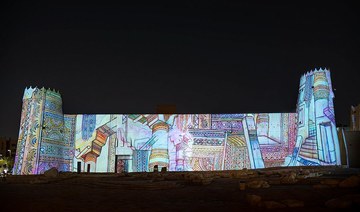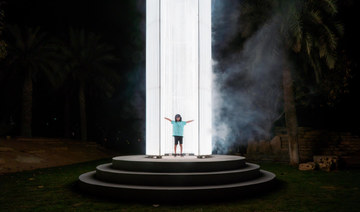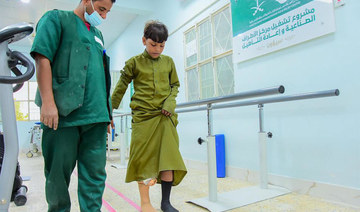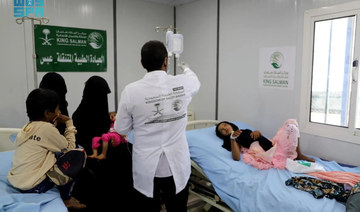RIYADH: Around 2,000 colored drones created stunning formations to electronic music in the sky above the King Abdullah Park in Riyadh on Wednesday to mark the opening of the second edition of Noor Riyadh.
The work by American artist Marc Brickman, titled “The Order of Chaos: Chaos in Order,” explored the effects of technology on humans through sound, light and motion.
Noor Riyadh, the Kingdom’s annual festival of light, features over 190 installations made by around 130 Saudi and international artists from over 40 countries.
The artworks at the three-week festival, on view until Nov. 19, can be found in 40 locations and five main hubs: Riyadh’s Diplomatic Quarter, King Abdullah Financial District, Salam Park, JAX District and King Abdullah Park.
Themed “We Dream of New Horizons” and reflecting optimism in renewal and transformation, this year’s festival is co-curated by Herve Mikaeloff, Dorothy Di Stefano and Jumana Ghouth.
The present edition is three times bigger than the first one staged in 2021, which celebrated the Kingdom’s past and rapidly changing present through artworks by over 60 Saudi and international artists, with 33 light installations.
Staged under the auspices of Riyadh Art, the first national public art initiative in Saudi Arabia that is part of the Royal Commission for Riyadh City, the event’s mission is to transform the metropolis into “a gallery without walls.”
The commission’s aim is to bring art to the city’s growing population and beautify Riyadh in order to transform it into one of the world’s most eco-friendly, livable and sustainable metropolises.
Some of the notable works are “The Garden of Light,” a video projection by Scottish-born Charles Sandison in the Diplomatic Quarter, emulating the virtual horizon created between history and the digital world; Daan Roosegaarde’s “Waterlicht” installation, which transforms water into light through dreamy reflections while sending an ecological message; and the colorful “Cupid’s Koi Garden” by art company Eness, which can be seen at Salam Park.
The festival also features Saudi artist Muhannad Shono’s breathtaking work, which transforms the surrounding area into a bold yet delicate structure emanating ethereal light at Bayt Al-Malaz.
The King Abdullah Financial District houses installations by Joel Adrianomerisoa, Tadashi Kawamata, Zineb Sedira, Douglas Gordon, Fabio Volpi, Vigas, Asaad Badawi and Jean-Michel Othoniel.
In the Diplomatic Quarter, one can also find artworks and commissions by Saudi and international artists such as Grimanesa Amoros, Alicja Kwade, Daniah Al-Saleh, Bertrand Lavier, Charles Sandison, Morgane Philippe, Ayman Yossri Daydban and Flightgraf.
Khalid Al-Hazani, Riyadh Art’s program director, said: “Noor Riyadh is a big part of plans to creatively transform the Kingdom’s capital into a vibrant, cosmopolitan global city through arts and culture.”
Saudi architect and designer Nouf Al-Moneef, Noor Riyadh’s project manager, told Arab News: “The theme this year is about generating hopefulness for the future.
“We have tripled in size from the first edition. Last year was about gathering under one sky and connectivity after the coronavirus pandemic, but this year we want to look into the future and feel the hope, passion and excitement that it has to offer,” she said.
Al-Moneef revealed that around 90 commissioned artworks will be safely kept for six months under Riyadh Art before being given back to the artists.
Over 500 events, including talks, workshops, panel discussions and performances will also take place to “enhance cultural vibrancy and social cohesion,” according to the exhibition’s catalog.
The festival will run alongside “From Spark to Spirit,” a three-month art exhibition that will take place from Nov. 3 to Feb. 4, 2023 at JAX District in Riyadh. It is curated by Neville Wakefield and Saudi associate curator Gaida Al-Mogren.
The exhibition boasts artworks by some of the biggest global artists like Larry Bell, Alicja Kwade and Philip K. Smith III, alongside Saudi artists such as Hmoud Al-Attawi, Zahrah Al-Ghamdi, Moath Alofi, Walaa Fadul and Daniah Al-Saleh. It also features rising regional artists such as Emirati Zeinab Al-Hashemi and Bahraini artist and architect Noor Al-Wan.
The exhibition presents multimedia works, with a high emphasis on technology, that capture human fascination with the mystery and power of light.
Local and international visitors, high-profile art curators, artists and professionals are all flocking to see the artworks.
“We want everyone to experience this light festival. We are covering north, east, west and south — everywhere in the city — and we want everyone to experience it,” said Al-Moneef.









































